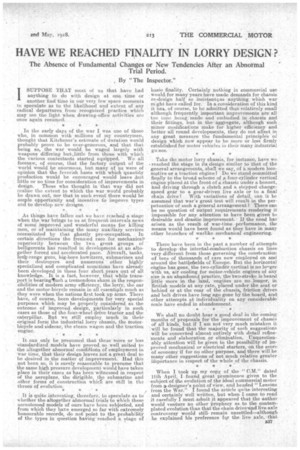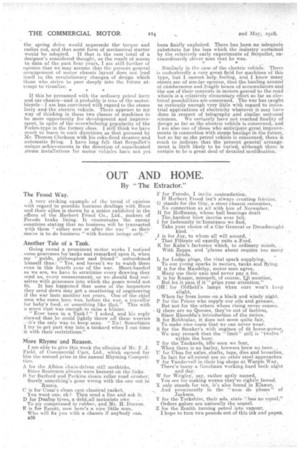HAVE WE REACHED FINALITY IN LORRY DESIGN?
Page 15

Page 16

If you've noticed an error in this article please click here to report it so we can fix it.
The Absence of Fundamental Changes or New Tendencies After an Abnotrnal Trial Period.
. By "The Inspector." . , ISUPPOSE THAT most of us that have had anything to do with design at one, time or another find time in our very few spare moments to speculate as to the likelihood and extent of any radical departures from recognized practice which may see the light when drawing-office activities are
once again resumed.
In the early days of the war I was one of those who, in common with nillliona of my countrymen, thought that Kitchener's estimate of duration would probably prove to be over-generous, and that that being so, the war would be waged largely with weapons differing butelittle from those with which the various contestants started equipped. We all foresaw, of course; that the factory output of the world would be enormous, but many of us were of opinion that the feverish haste with 'which quantity production would be encouraged would leave \but little or no time for consideration of improvements in design. Those who thought in that way did not realize the extent to which the war would probably be drawn out, nor that in such event there would be ample opportunity and incentive to improve types and to develop new designs..
As things have fallen out we have reached a stage when the war brings to us at frequent intervals news of some improved and wonderful means for killing men, or of maintaining the Many auxiliary services necessitated by that ghastly pre-occupation. In certain directions the frenzied race for mechanical& superiority between the two greab groups of belligerents has resulted in development at an altogether forced and accelerated paee. Aircraft, tanks, leat-range guns, big-bore howitzers, submarines and theirdestroyers and numerous other highly specialized and complicated munitions have already been developed in these four short years out of all knowledge. It is a fact, however, that while transport.is bearingtuch a tremendous share in the responsibilities of modern army efficiency, the lorry, the car and the motor-bicycle remain in all essentials much as they were when the nations first took up arms. There have, of course, been developments for very special purposes which may be .properly considered as the outcome of improved design, particularly in such , cases as those of the four-wheel drive tractor and the caterpillar. But we still' employ much in thew original forth the industrial lorry chassis, tho Motorbicycle and sidecar, the steam wagon and the traction engine.
It can only be presumed that these more or less standardized models have proved so well suited to the altogether abnormal conditions of employment in war time, that their design leaves not a great deal to be desired in the matter qf improvement. Had this not been so, it is surely reasonable to Presume that the same high pressure development would have taken place in their eases as has been witnessed in respect of the aeroplane, the dirigible, the submarine and other forms of construction whicri are still in the throes of evolutien.
•
It is quite interesting, therefore, to speculate as to whether the altogether abnormal trials to whkh these accustomed models of ours-' have been subjected, and from which they have emerged so far with extremely honourable records,. do not point to the probability of the types in question having reached a stage of basic finality. Certainly nothing in commercial use would-for many years have made demands for Chassis re-design half so insistenttas anything which war might have called for. In a consideration of this kind it ha,a, of course, to be admitted that-relatively small although frequently important improvements are all tee time being: made and embodied in chassis and their fittings, hut in the aggregate, although such minor modifications make for high-er efficiencyand better -all round developments, they do not affect in any great measure the fundamental principles design which how appear to be more or less firmly establiShed.for motor vehicles in their many industrial gu iees.
Take. the motor lorry chassis, for instance, have we
• reached the stage in its design similar to that of the general arrangements, shall we say, of a modern locomotive or a traction engine? Do we stand committed finally to the broad scheme of a four-cylinder vertical engine placed at the front of a chassis under a bonnet, and driving through a clutch and a. stepped .change speed gear to a gear-driven live axle or to a final chain drive? With variations of detail, can it be assumed that war's great test will result in the perpetuation of-such a general arrangement ? There can be no question of output requirements -rendering itimpossible for any attention to have been given to desirable and drastic improvement.: If the need has arisen as the result Of war-time performance, the means would have been found as they have in many other branches of warlike mechanical engineering.
There have been in the past a number of attempts to developthe internal-combustion chassis on lines very different from those governing the construction of tens of thousands of cars now employed on and around the battlefields of Europe. But the horizontal engine has gone, the two-cylinde-r vertie..al is no longer with us, air cooling for motor-vehicle engines of any size is an abandoned practice', the two-stroke is heardlittle more in the land, engine-s are no longer, in British models at any rate, placed under the seat or behind or at the rear of the chassis, friction drives and belt drives have long ago gone by the board, and other attempts at individuality on any considerable scale have ended in abandonment We shall no doubt hear a good deal in the .coming months of proposals for the improvement of chassis of all kinds, but if I am not very much mistakenit :will be found that the majority of such suggestions will be-concerned almost entirely with detail refinements and elaboration or elimination. Unquestionably attention will be given to the possibility of improved mechanical or electrical starters, on the score of economy if for no other purpose, and there "will be many other suggestions of not much relative greater ifirportance in respect of the whole of the chassis.
When I took up my copy of the "0M." dated 11th April, I found great prominence given to the --subject of the evolution of the ideal commercial motor from a. designer's pohit of view, and headed "Lessons from the War." I found the article quite interesting and certainly well written, but when. I came to read it carefully I must admit it appeared that the author would venture no other iprophecy as to the contemplated evolution than that the chain_ drive,and live axle controversy would still' remain unsettled—althciugh he explained his preference flar the live axle, that B37 the spring drive would supersede the torque and radius rod, and that somaform of mechanical starter would be adopted. If that is the sum total of a designer's considered thought, as the result of access to data of the past four years, I am still further of opinion that we may assume that the present general arrangement of motor chassis layout does not lend itself to the revolutionary changes, of design which those who strive to peer deeply into the future attempt to visualize.
If this be presumed with the ordinary petrol lorry and car chassis—and it probably is true of the motorbicycle—I am less convinced with regard to the steam lorry and-the electric vehicle. There appears to my way of thinking in these two classes of machines to be more opportunity for development and improvement, in spite of the overwhelming popularity of the Foden-type in the former class. I still think we have much to learn in such directions as that pursued by Mr. Thomas Clarkson with his coke-fired steamer and automatic firing. I have long felt that SerpoIlet's unique achievements in the direction of ,superheated steam installations for motor vehicles have not yet been finally exploited. There has been no adequate substitute for the loss which the industry-sustained by the relatively early experiments of Serpollet, extraordinarily clever I.nan that he was.
Similarly in the ease of the electric vehicle. There is undoubtedly a very great field for machines of this type,. but I cannot help feeling, and I know many others are of similar opinion, that the hauling around of cumbersome and fragile boxes of accumulators and the use of their contents, in motors geared to the Toad wheels is a relatively elementary effort so far as electrical possibilities are .concerned. The War has taught us curiously enough very little with regard to industrial applications of electricity whatever it may have .done in respect of telegraphy and similar sectional sciences. We certainly have not reached finality of design so far as the electric vehicle is concerned, and I am also one of those who anticipate great improvements in connection with steam haulage in the future, but so far as_the petrol vehicle is concerned, there IS much to indicate that the 'present general:arrangement is litt.M likely to be varied, although there is certain to be a great deal of detailed modification.' '•






















